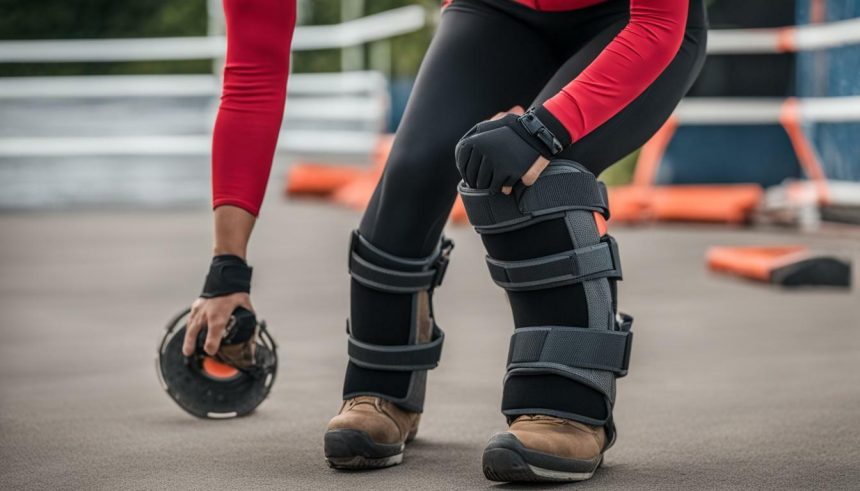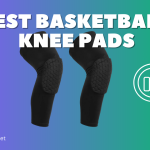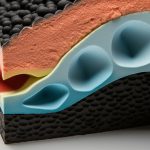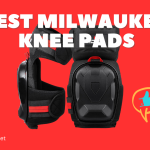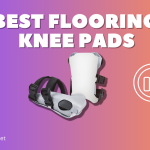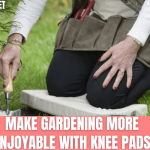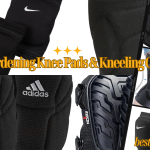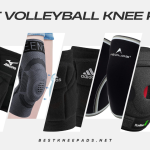If you engage in activities that require knee protection, wearing knee pads is crucial. However, simply wearing them isn’t enough. To ensure optimal comfort and protection, it’s important to wear knee pads properly. Here’s what you need to know:
Key Takeaways
- Wearing knee pads is essential for protecting your knees during physical activities.
- Proper knee pad positioning is important for optimal protection.
- Knee pads must fit snugly to provide the best level of comfort.
Choosing the Right Knee Pads
Choosing the right knee pads is essential for optimal comfort and protection during various activities. With so many different types of knee pads available, it can be overwhelming to decide which ones are best for you.
The first step in selecting knee pads is to determine what type of activities you will be using them for. If you’re engaging in high-impact sports such as basketball or volleyball, you may want to consider knee pads with thick padding and a hard shell for maximum protection. For less intense activities such as yoga or cycling, lighter-weight knee sleeves may be more suitable.
Once you’ve determined the type of knee pads you need, it’s important to consider the features that are most important to you. Some knee pads come with adjustable straps for a customized fit, while others are designed with moisture-wicking materials to keep you cool and dry during intense workouts.
Tip: Read reviews online and consult with knowledgeable salespeople to help narrow down your choices.
Lastly, consider the price range you’re willing to invest in knee pads. While more expensive knee pads may offer advanced features and higher levels of protection, there are also budget-friendly options available that still provide adequate protection and comfort.
Measuring for Proper Fit
Properly fitting knee pads are essential for both comfort and protection. Before purchasing knee pads, it’s essential to measure your knees to ensure an ideal fit. Ill-fitting knee pads can restrict your movement and even cause injury.
Begin by measuring the circumference of your knee at its widest point. Use a measuring tape to wrap around the knee, making sure it’s snug but not too tight. Record the measurement in inches.
Next, measure the length of your knee from the bottom of the kneecap to the top of the shinbone. Use the same measuring tape, and record your measurement in inches.
Make sure to take measurements on both knees to ensure consistency. Compare the measurements to the manufacturer’s sizing chart to determine the right size for you. If your measurements fall in between sizes, it’s best to go for the larger size for optimal comfort.
Remember, knee pads should fit snugly but not so tight that they cause discomfort or restrict movement. A well-fitting knee pad should stay in place while you move and provide adequate coverage to the knee area.
Putting on Knee Pads Correctly
Now that you have your knee pads, it’s time to learn how to put them on correctly. The following steps will ensure proper positioning and secure fastening:
- Start with clean, dry skin: It’s important to make sure your knees are clean and dry before putting on knee pads. Moisture can cause the pads to slip or rub against your skin, causing discomfort.
- Don the knee pads: Slip the knee pad over your knee, positioning the hard shell over your kneecap. The top of the pad should be about an inch or so above your kneecap.
- Secure the knee pads: Fasten the straps around your leg, making sure they are snug but not too tight. The straps should keep the knee pads in place and prevent them from sliding down your leg during activity.
By wearing knee pads correctly, you can ensure optimal protection and comfort during various activities. Don’t forget to adjust the positioning of your knee pads properly for the best coverage, and test your range of motion to make sure the pads don’t restrict your movement.
Adjusting Knee Pad Positioning
Once you have put on your knee pads correctly, it’s essential to adjust their positioning to provide maximum protection. Properly positioned knee pads will cover the vulnerable areas of your knee, reducing your chances of injury.
When positioning your knee pads, ensure they are centered over your kneecap, covering the front and slightly wrapping around the sides. Adjust the straps or fasteners to ensure a snug, secure fit without being too tight. Make sure the knee pads do not shift out of position during activity.
When aligning knee pads, it’s important to note that each knee pad has a specific design to fit each knee’s anatomy. Ensure that your left knee pad is on your left leg and vice versa. The knee pads’ shape should fit the contour of your knee for maximum coverage.
If you are using knee pads for sports, make sure they meet the requirements of the sport you are participating in. For example, some sports require knee pads to cover a specific area of the knee.
When adjusting the knee pad placement, consider your level of activity. If you perform high-impact activities like jumping or diving, make sure the knee pads have extra padding or protection in those areas. You may also want to consider wearing knee sleeves or compression shorts to provide additional support.
In summary, correct knee pad placement is essential for optimal protection. Always adjust the positioning of your knee pads to ensure the vulnerable areas of your knee are adequately covered. Proper alignment, positioning, and placement of knee pads will reduce chances of injury and make your activities more comfortable.
Testing Knee Pad Range of Motion
After putting on your knee pads, it’s important to ensure that they allow for a full range of motion. Testing knee pad movement, flexibility, and mobility is essential to avoid restriction during activities.
Start by standing up and bending your knees, checking if the pads restrict your movement in any way. If you’re wearing larger or bulkier pads, you may feel some resistance, but it shouldn’t limit your mobility or cause discomfort.
Next, try walking around and engage in any movements specific to your activity, such as jumping or pivoting, to assess the flexibility of your knee pads. Make sure the pads stay in place and don’t slide or bunch up, which could be a sign of poor fitting.
If you’re not satisfied with the range of motion, try adjusting the positioning of your knee pads, such as moving them slightly up or down the leg. If that doesn’t help, you may need to consider getting a different type of knee pads or adjusting the size for a better fit.
Remember, testing the range of motion of your knee pads is crucial for optimal performance and protection during activities. Be sure to check them every time you wear them to avoid any discomfort or restriction.
Maintaining and Cleaning Knee Pads
Now that you know how to properly wear knee pads, it’s important to keep them clean and well-maintained to ensure they retain their protective qualities. Below are some essential tips for caring for your knee pads:
“Regular maintenance and cleaning are necessary to prolong the lifespan of your knee pads and keep them in optimal condition.”
Cleaning Knee Pads
After each use, wipe down your knee pads with a damp cloth to remove any sweat, dirt, or debris. For a deeper clean, you can hand wash them using a mild detergent and warm water. Avoid putting your knee pads in the washing machine or dryer, as this could damage the fabric and foam padding.
Storing Knee Pads
When not in use, store your knee pads in a cool, dry place to prevent mold and mildew growth. Avoid leaving them in direct sunlight or hot temperatures, as this could cause the foam padding to break down over time.
Consider investing in a knee pad storage bag or container to keep them organized and protected when not in use.
Replacing Knee Pads
If you notice any signs of wear and tear on your knee pads, such as holes, tears, or flattened foam padding, it may be time to replace them. It’s important to have knee pads that provide adequate protection for your knees to prevent injury.
By following these tips and regularly maintaining your knee pads, you can ensure they stay in good condition and provide long-lasting protection for your knees.
Conclusion
Congratulations on learning how to properly wear knee pads! By following the steps outlined in this guide, you can ensure that your knees are protected and comfortable during a variety of activities. Remember to choose the right knee pads for your needs, measure for proper fit, put them on correctly, adjust their positioning, test your range of motion, and maintain them properly for optimal performance.
Don’t forget that knee pads are an essential accessory for sports enthusiasts, gym-goers, and anyone who wants to protect their knees during physical activity. Investing in a quality pair of knee pads is a smart choice that can save you from costly injuries down the line. Whether you’re skating, running, lifting weights, or engaging in any other activity that puts stress on your knees, make sure you wear knee pads to stay safe and comfortable.
